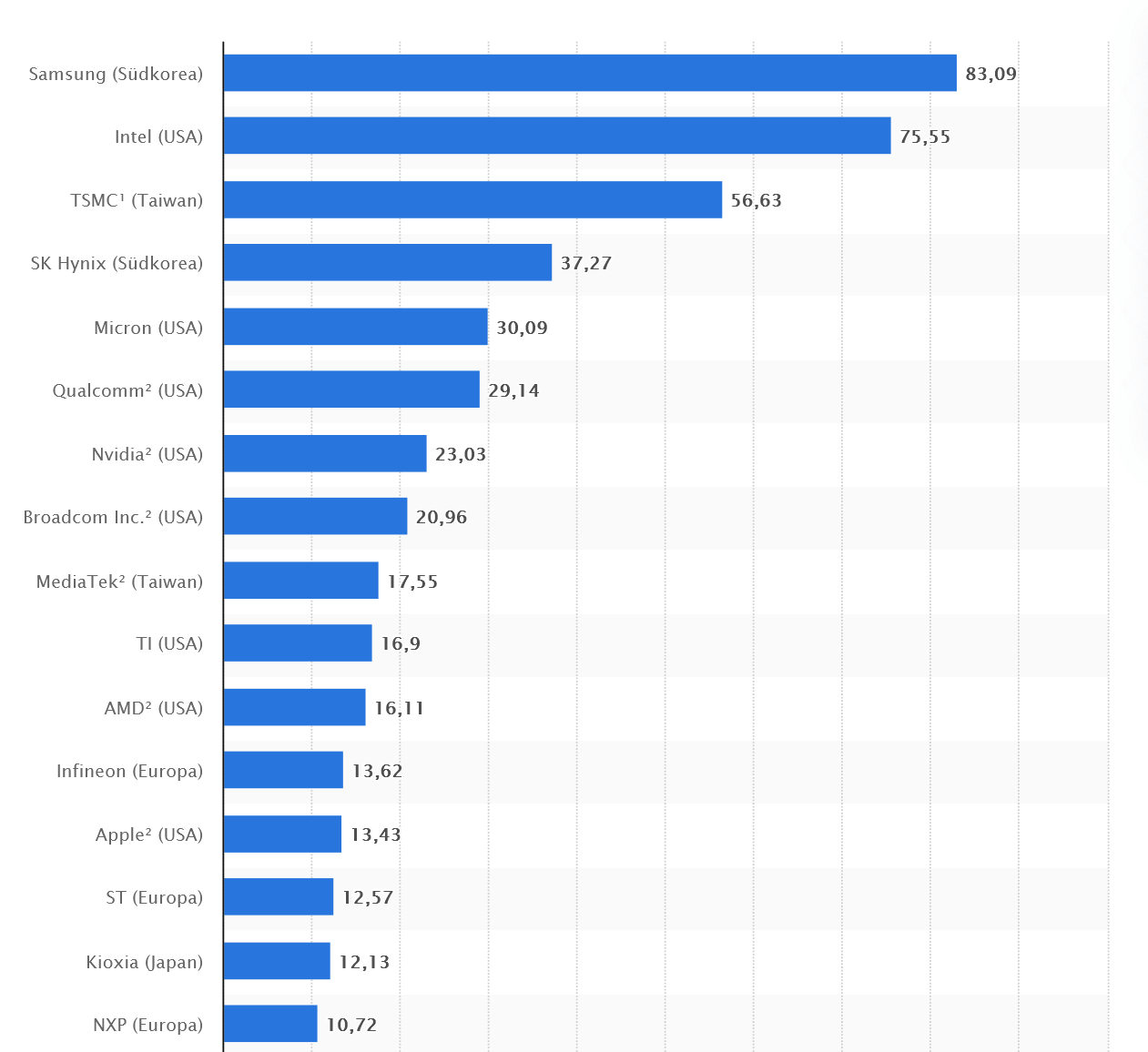Thousands of Chip Factories in China are shutting down
According to a report by DigiTimes, about 10,000 Chinese companies specializing in chip development have shut down operations between 2021 and 2022.
As part of the “Made in China 2025” strategy, the Chinese government has made increased efforts to strengthen the domestic semiconductor industry. This has led to a wave of start-ups in recent years, creating thousands of new companies in the chip industry. However, this strategy didn’t really work for various reasons, which is why most of their plants have now closed again.

Thousands of Chip Factories in China are shutting down
According to a report by DigiTimes, about 10,000 Chinese companies specializing in chip development have shut down operations between 2021 and 2022.
As part of the “Made in China 2025” strategy, the Chinese government has made increased efforts to strengthen the domestic semiconductor industry. This has led to a wave of start-ups in recent years, creating thousands of new companies in the chip industry. However, this strategy didn’t really work for various reasons, which is why most of their plants have now closed again.

China’s dependence on imported chips remains
China’s dependence on imported chips remains
In 2014, China launched the US$22 billion National Integrated Circuit Industry Investment Fund, also known as the “Big Fund“, as part of the “Made in China 2025” strategy to reduce its dependence on imported chips to reduce. So far, however, there has been no success. Currently, only 16 percent of semiconductors in China are locally produced, and these are among the least demanding in each category. Last year, China announced a second “big fund” to invest another $29 billion in semiconductor development. Despite these efforts, China still imports about 90 percent of the chips it needs.
The closure of the chip manufacturers has very different reasons. For example, there has been significant abuse of subsidies and corruption in the past. In addition, the “human factor” plays a crucial role: many new Chinese companies did not have the necessary management know-how to design or manufacture competitive chips. In addition, there is a lack of sufficiently qualified specialists in China who can work in this high-tech field. The largest chip manufacturer in the world remains the undisputed Samsung based in South Korea.
China’s zero-Covid policy has also contributed to the bankruptcy wave, as it led to a collapse in production and consumption in many developed countries around the world last year, severely affecting demand for domestic chips. In addition, US sanctions prevent the import of urgently needed technology and know-how to China.
The most advanced Chinese chip company is Semiconductor Manufacturing International Corporation (SMIC), based in Shanghai. Similar to Huawei, SMIC is on US Departments of Commerce and Defense watch lists, severely limiting its access to US technology and funding. Without foreign support, SMIC is still a long way from making a chip like the Kirin 9000 for smartphones, for example.
Wie Albert Einstein schon sehr treffend sagte: “Die Definition von Wahnsinn ist, immer das Gleiche zu tun und andere Ergebnisse zu erwarten”
The Kirin 9000, like other leading CPUs, was designed for silicon wafers that are five nanometers in size. In the case of semiconductors, the smaller the better. Currently, SMIC can only produce 14 nanometer chips. Although plans have been announced for making seven nanometer chips, they lack the appropriate machinery and tooling to make those plans a reality.
In an interview with Discourse, George Calhoun, a professor at the Stevens Institute of Technology in New Jersey, describes the “Beijing art of failure“: It is a top-down, Soviet-style program in which a lot of money is invested and Subsidies are provided for all. This has already been tried several times. In the latest round, Beijing rolled out a new set of incentives for semiconductor companies.
As Albert Einstein once said, “The definition of insanity is doing the same thing over and over and expecting different results.”
In 2014, China launched the US$22 billion National Integrated Circuit Industry Investment Fund, also known as the “Big Fund“, as part of the “Made in China 2025” strategy to reduce its dependence on imported chips to reduce. So far, however, there has been no success. Currently, only 16 percent of semiconductors in China are locally produced, and these are among the least demanding in each category. Last year, China announced a second “big fund” to invest another $29 billion in semiconductor development. Despite these efforts, China still imports about 90 percent of the chips it needs.
The closure of the chip manufacturers has very different reasons. For example, there has been significant abuse of subsidies and corruption in the past. In addition, the “human factor” plays a crucial role: many new Chinese companies did not have the necessary management know-how to design or manufacture competitive chips. In addition, there is a lack of sufficiently qualified specialists in China who can work in this high-tech field. The largest chip manufacturer in the world remains the undisputed Samsung based in South Korea.
China’s zero-Covid policy has also contributed to the bankruptcy wave, as it led to a collapse in production and consumption in many developed countries around the world last year, severely affecting demand for domestic chips. In addition, US sanctions prevent the import of urgently needed technology and know-how to China.
The most advanced Chinese chip company is Semiconductor Manufacturing International Corporation (SMIC), based in Shanghai. Similar to Huawei, SMIC is on US Departments of Commerce and Defense watch lists, severely limiting its access to US technology and funding. Without foreign support, SMIC is still a long way from making a chip like the Kirin 9000 for smartphones, for example.
Wie Albert Einstein schon sehr treffend sagte: “Die Definition von Wahnsinn ist, immer das Gleiche zu tun und andere Ergebnisse zu erwarten”
The Kirin 9000, like other leading CPUs, was designed for silicon wafers that are five nanometers in size. In the case of semiconductors, the smaller the better. Currently, SMIC can only produce 14 nanometer chips. Although plans have been announced for making seven nanometer chips, they lack the appropriate machinery and tooling to make those plans a reality.
In an interview with Discourse, George Calhoun, a professor at the Stevens Institute of Technology in New Jersey, describes the “Beijing art of failure“: It is a top-down, Soviet-style program in which a lot of money is invested and Subsidies are provided for all. This has already been tried several times. In the latest round, Beijing rolled out a new set of incentives for semiconductor companies.
As Albert Einstein once said, “The definition of insanity is doing the same thing over and over and expecting different results.”
Popular Posts:
Career booster 2026: These Microsoft Office skills will take you further!
A new year, new career opportunities! But which Office skills will really be in demand in 2026? "Skilled use" is no longer enough. We'll show you today's must-haves – like advanced Excel, using AI in the office, and relevant certifications for your resume.
Why Zero Trust doesn’t work without identity protection!
Zero Trust means: Trust no one, verify everyone. Identity protection is at the heart of this modern security model. Learn how IAM, MFA, Conditional Access, and the principle of least privilege effectively protect your business when the old network perimeter is gone.
How AI fuels cyberattacks – and how it protects us from them
Cybercriminals are using AI for deepfakes and automated attacks. Defenses are also relying on AI: through behavioral analysis (UEBA) and automated responses (SOAR). Learn how this arms race works and how modern security strategies can protect your business.
Information overload: Protection & tips against digital stress
Constantly online, overwhelmed by news, emails & social media? Digital information overload leads to stress and concentration problems. Learn the best strategies and practical tips to effectively protect yourself, manage the chaos, and regain your focus.
Put an end to password chaos: Why a password manager is important
Passwords are constantly being stolen through data leaks. A password manager is your digital vault. It creates and stores strong, unique passwords for every service. This effectively protects you against identity theft through "credential stuffing".
Stop procrastinating: How distraction blockers can help you regain focus
Constant digital distractions kill your productivity. Distraction blockers like Forest or Freedom help you regain focus. They specifically block distractions on your PC and mobile phone and use techniques like the Pomodoro Technique. This helps you stop procrastinating.
Popular Posts:
Career booster 2026: These Microsoft Office skills will take you further!
A new year, new career opportunities! But which Office skills will really be in demand in 2026? "Skilled use" is no longer enough. We'll show you today's must-haves – like advanced Excel, using AI in the office, and relevant certifications for your resume.
Why Zero Trust doesn’t work without identity protection!
Zero Trust means: Trust no one, verify everyone. Identity protection is at the heart of this modern security model. Learn how IAM, MFA, Conditional Access, and the principle of least privilege effectively protect your business when the old network perimeter is gone.
How AI fuels cyberattacks – and how it protects us from them
Cybercriminals are using AI for deepfakes and automated attacks. Defenses are also relying on AI: through behavioral analysis (UEBA) and automated responses (SOAR). Learn how this arms race works and how modern security strategies can protect your business.
Information overload: Protection & tips against digital stress
Constantly online, overwhelmed by news, emails & social media? Digital information overload leads to stress and concentration problems. Learn the best strategies and practical tips to effectively protect yourself, manage the chaos, and regain your focus.
Put an end to password chaos: Why a password manager is important
Passwords are constantly being stolen through data leaks. A password manager is your digital vault. It creates and stores strong, unique passwords for every service. This effectively protects you against identity theft through "credential stuffing".
Stop procrastinating: How distraction blockers can help you regain focus
Constant digital distractions kill your productivity. Distraction blockers like Forest or Freedom help you regain focus. They specifically block distractions on your PC and mobile phone and use techniques like the Pomodoro Technique. This helps you stop procrastinating.


































